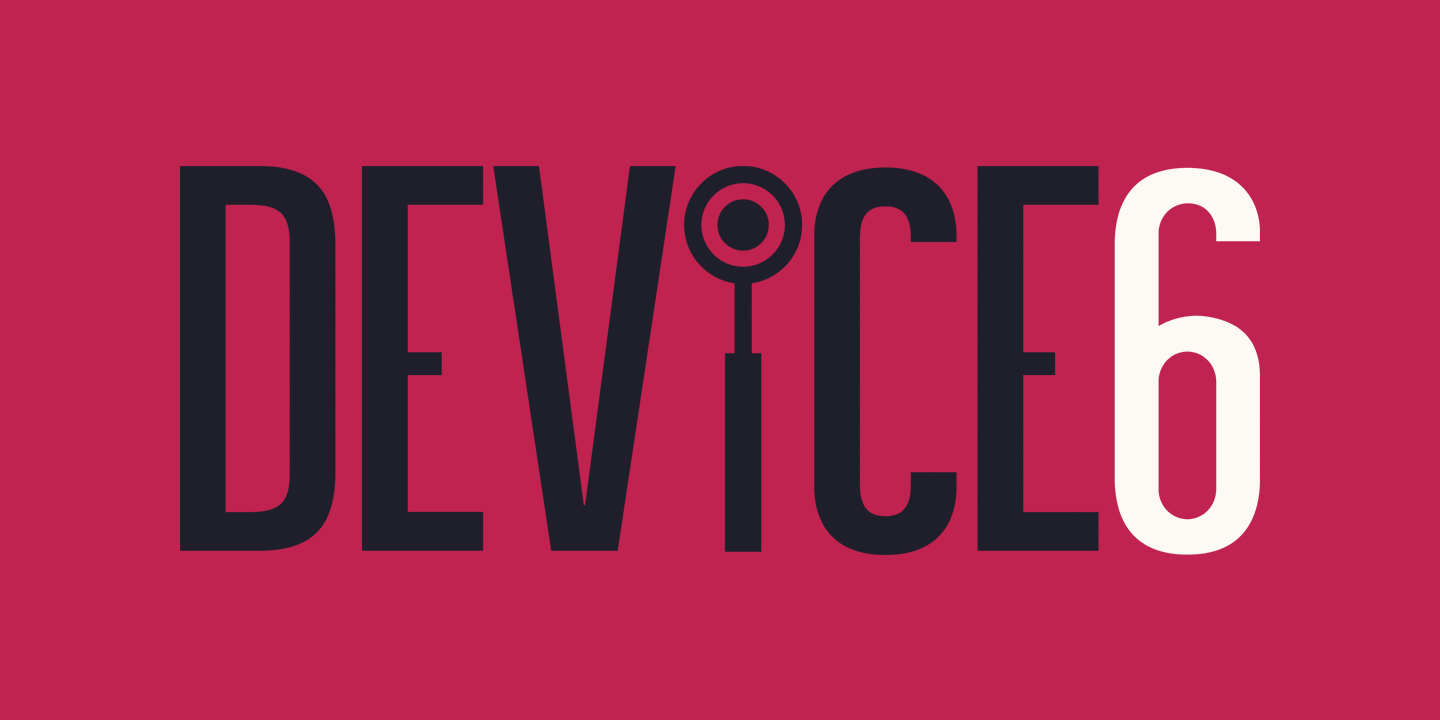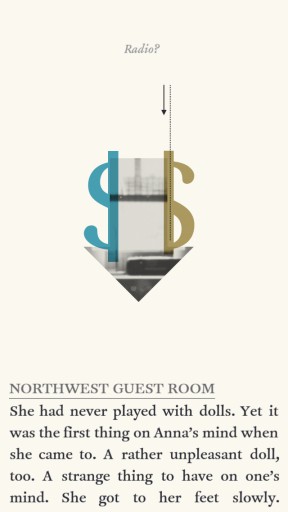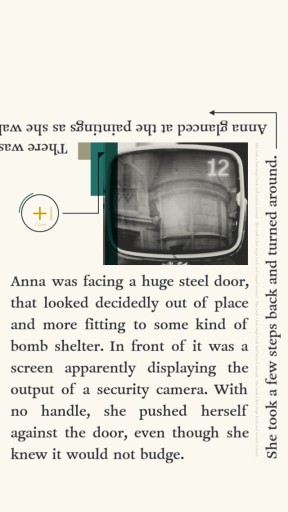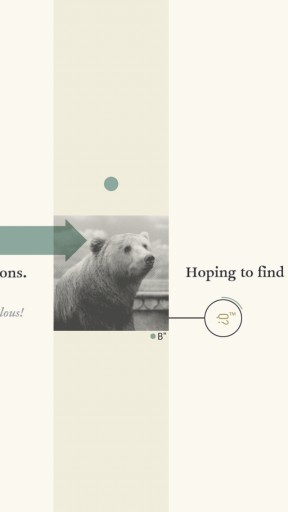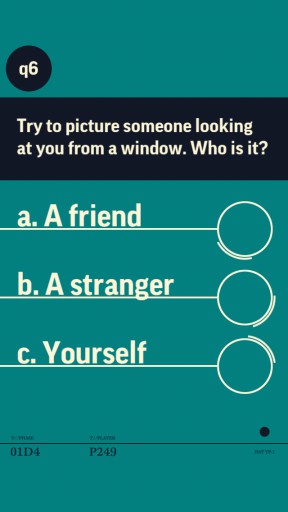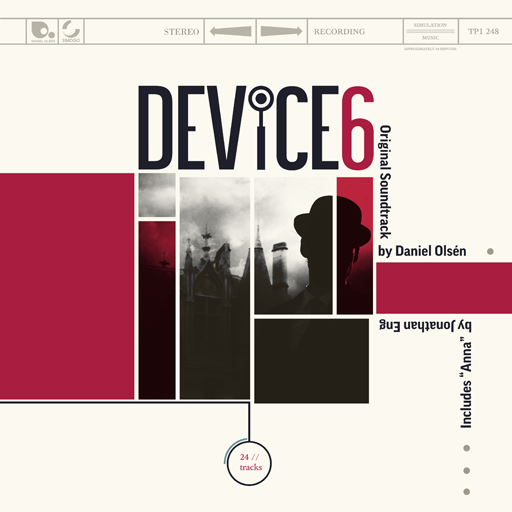
DEVICE 6

Title:
DEVICE 6

Genre:
Textual Thriller

Release date:
Oct 17, 2013
A surreal thriller in which the written word is your map.
DEVICE 6 plays with the conventions of games and literature, entwines story with geography and blends puzzle and novella, to draw players into an intriguing mystery of technology and neuroscience.
Anna wakes up in a castle on a remote island, with little recollection of how she got there. All she remembers is an unusually unpleasant doll.
Why are there two identical castles on the island? Who is the mysterious man in the bowler hat? And above all, what is the purpose of the tests Anna is put through?
Read, listen and peek into three-dimensional photographs to solve the bizarre mysteries of DEVICE 6.

Gameplay & Development
In DEVICE 6, players navigate six chapters, each a map built using text, by swiping their fingers across the screen. At certain junctures, the text may rotate or branch out, reflecting both the main character’s actions within the journey, as well as her spatial position in the current area. To complete each chapter, players must complete a larger puzzle, composed of several small puzzles, with hints scattered around the chapters in text and images. Each chapter has various intermissions, in which the players are asked to take part in and complete various tests. Throughout the game, players are faced with several meta-elements, which aims to make them consider their own part in the game.
After finishing up Year Walk for iOS, we immediately started work on the game that would become DEVICE 6. Year Walk had taken 10 months to develop, and now we wanted to make a game in about half the time, using the knowledge and experience we had obtained during the development of Year Walk. We analyzed which factors had been most time consuming to produce in Year Walk, and came to the conclusion that art production, and everything related to it, was one of the largest time sinks, while the fact that the game took place in one big world, made the production unruly and less open to iteration. The game not being split up into levels or chapters, was also one of the biggest contributors to bugs, and added a lot of time spent testing the game. And so, we decided that the next game needed to have a more traditional level structure, with smaller secluded areas (which the player could not return to once completed), and a minimal art style, with art assets that could be produced at a fast pace.
The reason DEVICE 6 ended up having six chapters, was simply because we didn’t want the production to take more than half a year, and we thought that one month per chapter was a reasonable time frame for the production. This led to the DEVICE 6 releasing in the same year as Year Walk, and so they became considered to be somewhat of a duo of games—but we consider them to be part of an unofficial trilogy, ending with the The Sailor’s Dream.
After we had examined which were the production heaviest parts of Year Walk, we started exploring which elements we found most interesting about it. Puzzles, the fourth-wall breaking meta-elements, a story focus and navigating a 2D world by swiping, were the key elements we wanted to bring to the next project. Along the way, we started talking about having the entire game being based around navigating 2D maps. While exploring this idea, we came up with idea of building these maps with text. We figured that paragraphs could be rooms, and longer separate sentences could be corridors. Space and time would become one; if players swiped back in a map, they would essentially also travel back in the story, and having crossroads in going east or west, would actually also be a choice of action for the protagonist. The idea to have the game be based around escaping secluded places, with one “master puzzle” per chapter, was inspired by 999: Nine Hours, Nine Persons, Nine Doors
Following the gameplay discussions, we started talking about story ideas with Jonas Tarestad. At the time, Simon was very into the 1960s TV-show The Prisoner
We thought DEVICE 6 would be a hard sell, but it ended up being our most successful game, and got a lot of nominations for several prestigious awards. One of the nominations led us to designing a mysterious physical version of the game.

Images
Everything in DEVICE 6’s art, from the small tech blurbs, to the buttons, has an explanation tied to the narrative. We wrote a guide to ourselves, which explained how the mysterious organization HAT, and their different devices operated. To create an art style that could match these technical explanations, we looked for inspiration in maps, infographics, diagrams, blueprints, old black and white photographs, and typography. The album covers of Sam Suliman



For DEVICE 6 we had to learn a lot about font rendering and text alignment, and ended up making a lot of custom solutions for displaying text, as our paragraphs and words needed to be able to do a lot of tricks that no existing solution could do effectively at the time.
To promote the game, we created two different posters which were sold through Fangamer. One of the posters became the basis for a wallpaper.

Videos
Because of its focus on texts, and the user interactions with it, creating trailers and promotional videos for DEVICE 6 was difficult. As gameplay looks dull when displayed in a video, we instead tried to communicate the feeling of game, and its suspense, by creating custom animations, inspired by the different motions of UI elements appearing in the game.
The animation in-game was mainly used to attract attention to interactive elements in each chapter. Different UI elements appeared through various fun animations, as they scroll in. Still, we thought there was a more immersive element missing. We wanted to suggest what the protagonist Anna was going through, without completely showing it. What if you could only peek in through small windows? We made some quick tests

To create the illusion of depth, we wanted them to feel as if the player was looking through holes in the story, with parallax scrolling. But, the increasing resolution variations on iOS devices led to a lot of problems. “Visions” differed too much from device to device. So, the final implementation of the visions are animations playing on small rectangles, which are rendered using a completely still camera. To display the visions, we kept track of where the player had scrolled to, so we knew where the vision should be shown and how big they should be, and which frame of the animation should be displayed. This only allowed us to display one vision at a time, but the tradeoff was worth it.

Music
As DEVICE 6 relied so heavily on text, we knew early on that we needed to create a rich and believable soundscape. We spent a lot of time adjusting exactly where sounds should play, as reading speeds would vary a lot between players. Enthused by the idea of writing a 60s-style soundtrack with brass and strings, Daniel Olsén returned to compose the music for DEVICE 6. His score featured a lot of synthesized sounds, using a breath controller and mod wheel to affect the filters and values of the sounds. This made them come to life in a very expressive way and feel organic. These sounds inspired the entire sound design for the game, and ended up being used as sound effects outside the music.
We were inspired by how TV-shows like The Prisoner used incidental jingles to create suspense, and just like The Prisoner

Close to the culmination of the story, we wanted to have a musical performance. In a suitably meta-fictional manner, Jonathan Eng appears as himself, performing his song “Anna”.

Game Credits
Art, sound & direction by
Simon Flesser
Produced & programmed by
Magnus “Gordon” Gardebäck
Written by
Jonas Tarestad
Logo design
Åsa Wallander
Music by
Daniel Olsén
“Anna” written and performed by
Jonathan Eng

Reviews, Press & Awards
Reviews
Metacritic
Eurogamer
IGN
PC Mag
In using its text both as narrative and as geography – and through its impressively restrained use of illustration and sound – it generates an almost unrivalled sense of place. It isn’t embarrassed to allow Device 6 to be a game when it needs to be, and yet it knows precisely when to let the story take over. The result is a sharp, striking mystery that is at once provocative, extraordinarily stylish and altogether essential
Edge – 9/10
Press
The Millions: A Year In Reading: Reif Larsen
Kill Screen: DEVICE 6 is a mystery game that creates as many mysteries as it solves
The Verge – ‘Device 6’ is a stylish mystery novel masquerading as a game
Awards
Apple Design Award 2014 (Winner)
Artistic Achievement at BAFTA Games Awards 2014 (Nominated)
Mobile and Handheld at BAFTA Games Awards 2014 (Nominated)
Audio Achievement at BAFTA Games Awards 2014 (Nominated)
Audio Accomplishment at Develop Awards 2014 (Finalist)
Use of Narrative at Develop Awards 2014 (Finalist)
Best Handheld/Mobile Game Award at Game Developers Choice Awards 2014 (Nominated)
Innovation Award at Game Developers Choice Awards 2014 (Nominated)
Best Entertainment App at Global Mobile Awards 2014 (Winner)
Excellence in Audio at Independent Games Festival 2014 (Winner)
Excellence in Visual Art at Independent Games Festival 2014 (Nominated)
Excellence in Narrative at Independent Games Festival 2014 (Nominated)
Seumas McNally Grand Prize at Independent Games Festival 2014 (Nominated)
Excellence in Design at Independent Games Festival 2014 (Honorable Mention)
Nuovo Award at Independent Games Festival 2014 (Honorable Mention)
Excellence in Innovation at International Mobile Game Awards 2014 (Nominated)
Excellence in Sound Design at International Mobile Game Awards 2014 (Nominated)
Excellence in Storytelling at International Mobile Game Awards 2014 (Nominated)
Best Nordic Handheld Game at Nordic Game Awards 2014 (Nominated)
Best Nordic Innovation Award at Nordic Game Awards 2014 (Winner)
Best App Ever Award at Pocket Gamer Awards 2014 (Nominated)
Most Innovative Game Award at Pocket Gamer Awards 2014 (Winner)
Best Adventure Game Award at Pocket Gamer Awards 2014 (Honorable Mention)
Swedish Game App of the Year Award at Dataspelsgalan (Nominated)
App Store Editors’ Choice
App Store Game of the Year
(Runner-Up)

